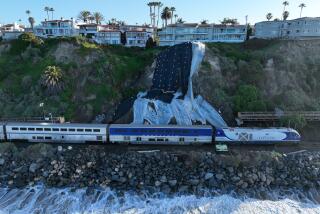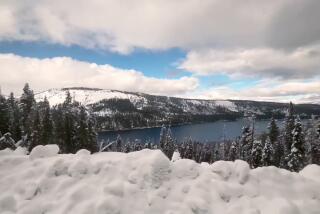Ecuador’s newly reopened Cruise Train connects present day to history
QUITO, Ecuador — As the four-car train rolls through the clouds and begins its descent of the Andes, Bette Bleeker has a practical concern.
“I hope someone checked the brakes,” the Chicago resident asks.
It’s a fair question, given the 1,755-foot descent we’re about to make on the Devil’s Nose, one of the steepest sections of railroad in the world. The historic route requires several switchbacks, including one length where the train reverses direction and heads backward as it gingerly stair-steps down the highlands.
But the train engineers aren’t about to tempt fate. They had stopped for a safety inspection while passengers aboard Ecuador’s new Tren Crucero, or Cruise Train, relax after a lunch of quinoa salad, pumpkin soup and braised llama.
Our zig-zaggy adventure down the mountain safely unfolds just as envisioned a century ago. Instead of cutting-edge transportation, the route offers a slow-speed panorama of Ecuador from Quito, the capital, at nearly 10,000 feet, to the sea-level port city of Guayaquil (or in reverse). I had come to soak up the Andean scenery, stopping frequently to explore the villages, colonial churches, plantations and volcanoes along the way.
Although I’m not a “foamer” — a railroad fanatic — I am impressed by the Devil’s Nose experience because it’s a chance to experience a transportation marvel of another age.
On some runs, the train’s brakemen must remove animals that have been tied to the track. With the train service suspended for years, farmers were in the habit of securing livestock to the steel rails.
There are other complications too. The four-day, three-night train trip requires intricate, behind-the-scenes coordination. Tour buses carrying our luggage follow the train; security officers on motorcycles race along the track in order to guard unmarked road crossings.
The train, which restarted service in June, is still a national novelty. Along the 283-mile trip, we’re greeted by waving kids and adults excited that life has returned to the historic line. When the bright-red cars crawl through the middle of towns, automobiles pull over to honk in celebration.
Our journey passes through the Avenue of Volcanoes, a line of more than a dozen towering peaks named by 19th century German explorer Alexander von Humboldt. It also chugs through industrial and historic towns, climbing to the nation’s highest train station, Urbania, at 11,840 feet. That’s where we meet Baltazar Ushca, who climbs to a glacier three days a week to cut 40-pound blocks of ice. The 69-year-old sells his harvest to a local market, where it’s used to make a fresh-juice slush.
The train begins to descend through hidden emerald valleys, past patchwork fields of potatoes, broccoli and quinoa. Then it clings to cliffs dotted with bromeliads. The ride ends (or begins) on the coast, where we chug through sugar cane and banana plantations.
The 37 mostly European and North American passengers read, chat and wander among the cars, which will hold 54 passengers. With complimentary cappuccino, soft drinks and juices, most everyone seems to have a drink, and in the afternoon we’re offered passion-fruit custard, cheese tamales or other snacks at our seats. The only extra charges are for alcohol and souvenirs, including miniature eye-poppingly graphic statues that look as though they could be from the South American Kama Sutra.
Our progress is deliberately slow, stopping for tours that leave from newly restored train stations. Any remnant of packaged tourism ends in Guamote, where we, the only non-indigenous visitors, step off the train directly into a crowded village market.
Wandering the streets, I find a group of native women dressed in bright pink, turquoise and royal blue ponchos and brightly embroidered skirts. I watch them haggle over the prices of disturbingly cuddly guinea pigs, pulling the furry creatures out of plastic sacks for inspection. The Andean delicacy known as cuy will be dinner that night.
We dine, instead, on a catered lunch of llama in the train station. It tastes like tough lamb, but chicken is available too.
One day we visit a cacao plantation, where we’re shown football-size pods that will be processed into chocolate. Another stop is at a native village where tribesmen don traditional costumes for a dance show and serve cups of fermented sugar cane juice.
The most colorful visit comes at Nevado Roses, 185-acre flower farm where a guide leads us through a fantasyland of millions of roses growing in mammoth greenhouses. Our tour is a week before Valentine’s Day, and the shipping area bustles with workers packaging the organically grown flowers, which in a few days will be presented to sweethearts on the other side of the planet. The Ecuadorean floral industry, which provides most of the roses to the U.S. and Russia, has blossomed in the last few decades with a boom in international air trade.
Ironically, it’s that growth that nearly killed the railroad. The line fell into disrepair after the 1960s when the newly constructed Pan-American Highway made truck traffic practical. Over time, the train provided transportation on the South American “hippie trail,” as passengers crowded into converted box cars or sat on the roofs.
“It was a great way to see the country. We went through the sun, the rain, the cold. The four seasons, practically,” says Katharina Baitschiger Ott, a Swiss native living in Ecuador.
After a series of floods wiped out tracks in 1998, the service seemed likely to go the way of the Incas.
Several years ago the Ecuadorean government declared the railroad part of the nation’s heritage and launched a $280-million project to upgrade the line. The country has experienced an oil boom of late and has been pouring money into tourism, opening a new international airport in Quito and restoring colonial gold-clad churches, which again shine like ornate jewel boxes.
But the train is perhaps the most surprising development. The new custom Spanish-built cars are works of art, each inspired by an era of Ecuadorean history. The front coach, for example, draws on the country’s Spanish heritage, gleaming with red and gold curtains, all observed by plaster cherubs smiling from the ceiling.
The second car nods to the country’s colonial period. Passengers don’t sit on utilitarian benches or airline-style seats; instead, they’re assigned to formal dining-room-style chairs paired with small tables. With dark paneling and brass fixtures, it feels as if a drawing room is slowly rolling across South America.
In another car, a bar area is paneled with stone that seems lifted from an Incan ruin. The last car includes a lounge inspired by the country’s Pacific coast, light and airy with wicker furniture and plenty of windows. There are modern touches too, such as electrical outlets to recharge phones and assigned lockers to stow carry-ons during excursions.
Through the journey we’re shadowed by the buses that ferry us on the tours and to hotels and haciendas every night.
On two nights, passengers are divvied up among comfortable homey historic hotels and converted mansions. The last night we fill a utilitarian but scenic motel-style lodge in the small mountain village of Huigra offering views of fog-misted valleys. Dinner is served in the hotel dining rooms with a choice of Ecuadorean seafood or meat dishes but no guinea pig. That’s a plus or minus, depending on your outlook on adventurous eating.
Not everything runs like clockwork. Because one section of track won’t be restored until December, a basic excursion train — with no bells or whistles, let alone hors d’oeuvres or bottled water — is used on the first day. Much of that time is spent on a bus tour of Cotopaxi National Park, and three British passengers are so disappointed they leave that afternoon.
But once we’re aboard the cruise train on the second day, it’s all smooth rolling. We quickly grow accustomed to click-clacking our way across the country toward the seaside city of Durán, which lies across the confluence of the Daule and Babahoyo rivers from Guayaquil.
For this last stretch, the train picks up a band, with guitar, drum and pan-flute players. Passengers dance in the aisles, and perhaps it’s no coincidence that the diversion comes just as we’re rolling through some of Ecuador’s worst slums, where people live in corrugated tin shacks on muddy lanes. But even here residents are out to greet us, taking cellphone pictures and waving as we roll past.
Along most of the route we’ve been pulled by a 2,400-horsepower French electro-diesel engine. But we switch to steam locomotives for two short stretches of track, including the final leg. It’s a dramatic finish with puffs of smoke, clanging bells and crying whistles.
That’s when Emerito Coello beams. The teacher, one of the few Ecuadoreans passengers, has brought her husband and elderly parents on the trip. Although she has loved the entire journey, she says it is worth it just to hear the familiar chug-chug of the steam train.
“That’s the sound I know from growing up,” she says with a smile. “That’s the train I remember.”
More to Read
Sign up for The Wild
We’ll help you find the best places to hike, bike and run, as well as the perfect silent spots for meditation and yoga.
You may occasionally receive promotional content from the Los Angeles Times.






